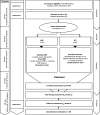Mentalization-based treatment versus bona fide treatment for patients with borderline personality disorder in Germany (MAGNET): study protocol of a prospective, multi-centre randomized controlled trial
- PMID: 40217262
- PMCID: PMC11992892
- DOI: 10.1186/s12888-025-06809-0
Mentalization-based treatment versus bona fide treatment for patients with borderline personality disorder in Germany (MAGNET): study protocol of a prospective, multi-centre randomized controlled trial
Abstract
Background: Borderline Personality Disorder (BPD) is a serious mental disorder. Mentalization-based treatment (MBT) is an evidence-based treatment for individuals with BPD. Specifically, MBT has previously been highlighted for its effectiveness regarding the reduction of suicidal and non-suicidal self-injury (NSSI). Yet, randomized-controlled trials (RCT) on MBT in outpatient settings compared with bona fide treatment (BFT) are still scarce and none has been conducted in Germany. The primary objective of this RCT is to investigate whether outpatient MBT is more effective in the reduction of crisis events (incidences of NSSI and suicide attempts) compared with BFT (namely psychodynamic or cognitive-behavioural psychotherapy) in Germany. Secondary, MBT's efficacy will be investigated with regard to cost-effectiveness within the German health care system, general and interpersonal functioning, BPD and general symptom severity, social adjustment, quality of life, reduction in psychotropic medication and therapy retention. Additionally, moderator as well as common and treatment specific mediator variables will be investigated.
Methods: Across 5 study sites in Germany, 304 individuals of all genders from age 18 to 65 with a BPD diagnosis and NSSI or suicide attempts in the past will be asked to participate in the study for a period of two years. In the first year, patients will receive either MBT or BFT and will take part in continuous scientific assessments. Scientific assessments will continue after therapy completion up to a 12-month follow up. As primary outcome, crisis events will be assessed via ecological momentary assessment (EMA) in one week per month (four weekly assessments) during the first year, and in one week every three months during the second year. Number of crisis events up to 2 years post randomization will be compared between treatment arms using a log-linear regression model following an intention-to-treat approach. Secondary outcomes and mediator variables will be assessed at several timepoints.
Discussion: This study investigates efficacy of MBT as BPD specific treatment in an outpatient setting compared with BFT in Germany. Results of this study can address a treatment gap in the German healthcare system, and inform about health economic aspects of BPD treatment as well as mechanisms of psychotherapeutic change.
Trial registration: NCT06018272, https://www.
Clinicaltrials: gov/ , August 30, 2023.
Keywords: Borderline Personality Disorder; Crisis events; Ecological Momentary Assessment; Health economy; Mechanisms of change; Mentalization-based therapy; Randomized controlled trial.
© 2025. The Author(s).
Conflict of interest statement
Declarations. Ethics approval and consent to participate: The Ethics Committee of the Medical Faculty Heidelberg (Germany) approved this study. The study is registered at clinicaltrials.gov with the number NCT06018272. Written informed consent to participate will be obtained from all participants. Consent for publication: N.a. Competing interests: The authors declare no competing interests.
Figures
References
-
- American Psychiatric Association. Diagnostic and Statistical Manual of Mental Disorders (DSM-5) 2013. http://www.dsm5.org/Pages/Default.aspx. - PubMed
-
- World Health Organization. International statistical classification of diseases and related health problems (11th ed.) 2021. https://icd.who.int/en.
-
- Volkert J, Gablonski T-C, Rabung S. Prevalence of personality disorders in the general adult population in Western countries: systematic review and meta-analysis. Br J Psychiatry. 2018;213:709–15. 10.1192/bjp.2018.202. - PubMed
-
- Grant B, Chou S, Goldstein R, Huang B, Stinson F, Saha T, et al. Prevalence, correlates, disability, and comorbidity of DSM-IV borderline personality disorder: results from the wave 2 national epidemiologic survey on alcohol and related conditions. J Clin Psychiatry. 2008;69:533–45. 10.4088/JCP.v69n0701. - PMC - PubMed
-
- Torgersen S. Epidemiology. The American Psychiatric Publishing textbook of personality disorders., Arlington, VA, US: American Psychiatric Publishing, Inc.; 2005, p. 129–41.
Publication types
MeSH terms
Associated data
LinkOut - more resources
Full Text Sources
Medical
Research Materials
Miscellaneous


